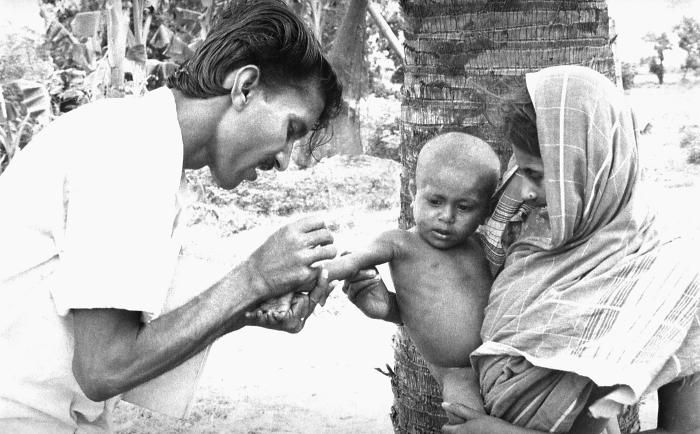[dt_button link=”http://d165vjqq8ey7jy.cloudfront.net/mp3/33266/se-8133s.mp3″ target_blank=”true” button_alignment=”default” animation=”fadeIn” size=”small” style=”default” bg_color_style=”custom” bg_color=”#333333″ bg_hover_color_style=”custom” bg_hover_color=”#444444″ text_color_style=”custom” text_color=”#ffffff” text_hover_color_style=”custom” text_hover_color=”#dddddd” icon=”fa fa-cloud-download” icon_align=”left”]Yuklash[/dt_button]
[dt_divider style=”thin” /]
Transcript:
Voice 1
Welcome to Spotlight. I’m Liz Waid.
Voice 2
And I’m Bruce Gulland. Spotlight uses a special English method of broadcasting. It is easier for people to understand, no matter where in the world they live.
Voice 1
In 1757, Great Britain and France were at war in North America. The people already living there, the Native Americans, were caught in the middle. Andrew J. Blackbird was a member of the Ottawa group of Native Americans. He wrote a history of his people. In it, he told a story about the war. Adam Navis tells this story:
Voice 3
“The Ottawas received a gift in a tin box. They were not to open it until they arrived back to their people. They believed that inside the box there was something to help their people. When the Ottawas arrived at their home, they opened the box. Inside there was another box, and another. Finally, they came to a very small box – only a few centimeters long. Inside this box was a small amount of particles that looked like dust.
The Ottawas investigated the dust. Many of them looked at it closely, but they did not know what it was. Soon after this, a terrible sickness invaded the Ottawa camp. Everyone who got this sickness died. They had been given a sample of the smallpox disease.”
Voice 2
Throughout history, smallpox has killed millions of people. But today, no one has smallpox. In fact, people could destroy it completely. But should we? Today’s Spotlight is on smallpox and the choice to keep or destroy remaining smallpox samples.
Voice 1
When someone is infected with smallpox she begins to show symptoms, or signs, after two weeks. Then she has two to four days of high fever. Then a rash appears – areas of the skin show red bumps, small raised areas. The rash begins on the face and legs. Then it spreads around the body. The rash turns into large bumps filled with liquid – pustules. After a time these pustules form scabs – skin that dries over the wounds. During this time, an infected person can spread the disease. Small particles of skin fall off the person. People breathe the particles and become infected. Smallpox is very contagious – it spreads very easily.
Voice 2
The smallpox virus kills about 30 percent of the people who get it. And in weaker populations like the very old or very young, the number is even higher. People who survive often show permanent marks of the virus. Many become blind. There is no cure for smallpox. When people become infected, the only treatment is to try and make them more comfortable.
Voice 1
But in 1796, Edward Jenner produced a form of protection against smallpox. It was a vaccine. Slowly, Jenner’s vaccine gained popularity. It also became more and more safe. People who received the vaccine injection BEFORE they got smallpox were safe. Soon, people all over the world were using and improving this vaccine.
Voice 2
In the 1950s and 60s the World Health Organization and other world leaders became serious about fighting smallpox. They produced a great amount of the smallpox vaccine. Teams travelled the world, giving the vaccine to every person. Then something happened that had never happened before in the history of the world. No person in the world had smallpox. The last natural case of smallpox was in Somalia in 1977. And in 1980, the WHO declared the world officially free of smallpox.
Voice 1
Today, people do not need to get the vaccine for smallpox. However, small amounts – samples – of this disease exist. There are two official samples located in two different laboratories. One is at the US Centers for Disease Control in Atlanta. The other is at VECTOR in Russia. These samples are stored safely in liquid nitrogen freezers. They are protected by many security measures. But the question is now: what do we do with these samples of this deadly virus?
Voice 2
Some experts believe that we should destroy the virus samples. They say we already have enough information about the virus. They say the virus samples are dangerous. One dishonest scientist could steal a small sample of the disease. He could sell it to be used as a weapon. Or, the virus could be released accidentally.
Voice 1
But other experts say that destroying the smallpox samples would be a mistake. They say people still have a lot to learn from the smallpox virus. Scientists still do not know exactly how it affects people – why it is so deadly.
Voice 2
It is also possible that the smallpox virus samples could be used to fight a different disease. For example, scientists in Canada have recently created a horsepox virus. It is similar to smallpox. The scientists hope to use it to develop vaccines and cancer treatments. Anthony Fauci is the head of the National Institute of Allergy and Infectious Disease in the United States. He told the Washington Post why people should not be worried about these experiments.
Voice 4
“Zika, influenza, and Ebola naturally change and evolve to become more dangerous. These things are much more of a danger to civilization than the possibility that someone may be able to create smallpox in a laboratory. People should concentrate on what we have been talking about for a long time: getting prepared for things that could actually threaten us.”
Voice 1
It is also difficult to know if all samples have been destroyed. All samples of smallpox are supposed to be officially recorded. But in 2014, six samples of smallpox were found in a laboratory in the United States. They had just been forgotten for many years. They were sent to the US Centers for Disease Control to be destroyed. But do other forgotten samples exist somewhere?
Voice 2
Finally, can people really decide to destroy something completely from the earth? The smallpox virus is deadly. But it is alive. Many people believe that only God should have the power to destroy something completely.
Voice 1
In both 2011 and 2014 this issue appeared before the World Health Assembly. Both times they agreed not to destroy the remaining samples. They could not agree on whether to destroy the samples or not. They decided to delay talking about the issue until later.
Voice 2
What do you think? Do you think the smallpox samples should be destroyed? Is the risk of keeping the samples worth the possible benefit? Tell us what you think. You can leave a comment on our website. Or email us at radio@radioenglish.net. You can also comment on Facebook at Facebook.com/spotlightradio.
Voice 1
The writers of this program were Liz Waid and Adam Navis. The producer was Michio Ozaki. The voices you heard were from the United Kingdom and the United States. All quotes were adapted for this program and voiced by Spotlight. You can listen to this program again, and read it, on the internet at www.radioenglish.net. This program is called, ‘Destroying Smallpox’.
Voice 2
Look for our listening app in the Google play Store and in iTunes. We hope you can join us again for the next Spotlight program. Goodbye.




